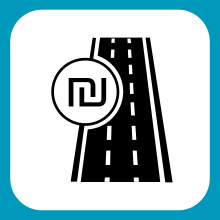Shekel sign
The shekel sign (₪) is a currency sign used for the Israeli new shekel, which is the currency of the State of Israel.
| ₪ | |
|---|---|
Shekel sign | |
| In Unicode | U+20AA ₪ NEW SHEQEL SIGN (HTML ₪) |
| Related | |
| See also | |

Israeli new shekel (1986–present)
The Israeli new shekel is denoted in Hebrew: שקל חדש (šéqel ħadáš, IPA: [ˈʃekel χaˈdaʃ], lit. "New Shekel") or by the acronym Hebrew: ש״ח ([ʃaχ]). The symbol was announced officially on 22 September 1985, when the first new shekel banknotes and coins were introduced.[1] It is constructed by combining the two Hebrew letters that constitute the acronym (the first letter of each of the two words, Hebrew is written from right to left): "ש" and "ח". Sometimes the "₪" symbol (Unicode 20AA) is used following the number, other times the acronym Hebrew: ש״ח.

The shekel sign, like the dollar sign ("$"), is usually placed left of the number (i.e. "₪12,000" and not "12,000₪"), but since Hebrew is written from right to left, this means that the symbol is actually written after the number. It is either not separated from the preceding number, or is separated only by a thin space.
Unlike the dollar sign, the new shekel sign is not used that often when handwriting monetary amounts.
The road sign announcing the entrance to an Israeli toll road, such as Highway 6 or the Carmel Tunnels, is a shekel symbol with a road in the background.
Unicode and input
The symbol has the Unicode code point U+20AA ₪ NEW SHEQEL SIGN (8362decimal · HTML ₪). It has been found in Unicode since June 1993, version 1.1.0.
According to the standard Hebrew keyboard (SI 1452) it must be typed as AltGr+A (the letter ש appears on the same key in regular Hebrew mode). It can be typed into Microsoft Windows on a standard Hebrew keyboard layout by pressing AltGr and 4 (Shift-4 produces the Dollar sign). The Shekel sign, however, is not drawn on most keyboards sold in Israel and the sign is rarely used in day-to-day typing. On an Ubuntu system it can be entered by holding down Ctrl+Shift+u, releasing (a u with an underline appears) and then typing the Unicode code point 20aa space. In Mac OS X it can be typed as Shift+7 when the system is set to a Hebrew keyboard layout.
Old Israeli shekel (1980–1985)
The old Israeli shekel, "![]()
See also
- Israeli shekel
- Israeli agora
- Currency sign
References
- Reshumot - Yalkut Pirsumin (Israeli official gazette, collection of miscellaneous announcements), Collection No. 3254, 14 Tishrei 5746, 29 September 1986, p. 430, ISSN 0334-2980 (in Hebrew).
- Reshumot - Yalkut Pirsumin (Israeli official gazette, collection of miscellaneous announcements), Collection No. 2619, 27 Nisan 5740, 13 April 1980, p. 1423, ISSN 0334-2980 (in Hebrew).